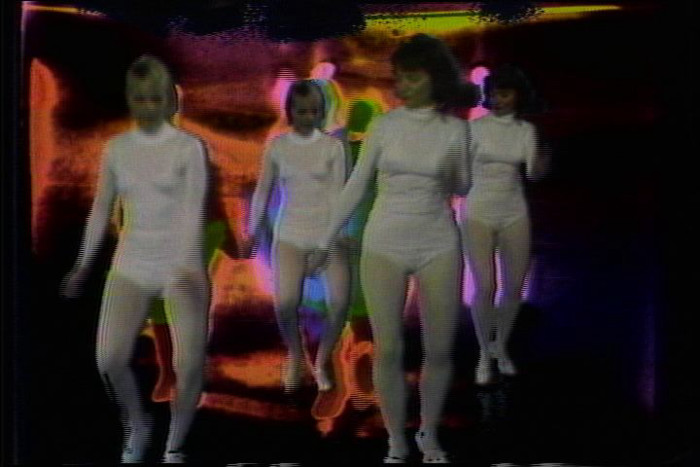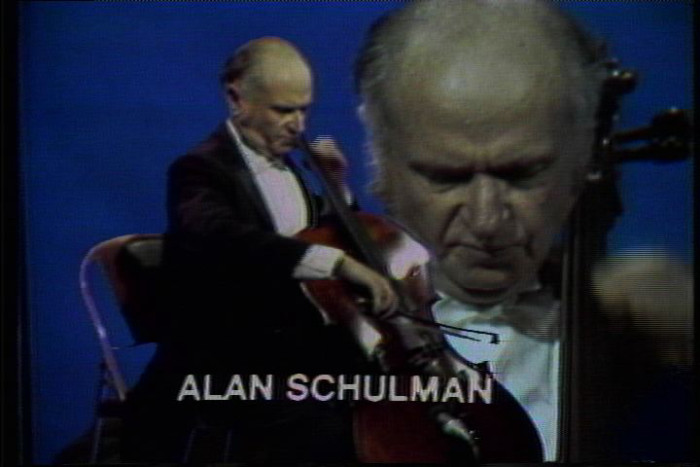GGC
Nam June Paik Exhibition Nam June Paik Media ‘n’ Mediea
Nam June Paik Art Center
For more information on 'Exhibition', please visit the Nam June Paik Art Center. |
Nam June Paik Exhibition Nam June Paik Media ‘n’ Mediea

■ Introduction
“Like McLuhan say, we are antenna for changing society. But not only antenna 〔…〕
My job is to see how establishment is working and to look for little holes where I can
get my fingers in and tear away walls.” (Nam June Paik)
Nam June Paik Media ‘n’ Mediea explores the message embedded in “Nam June Paik Media” which not only acutely captured the contemporary society, but also envisaged a new future through the artistic intervention in technology, and therefore, is still so contemporary and alive.
The exhibition featuring the works from the NJP Art Center’s the major collection is organized around Paik’s Global Groove (1973), “a kind of imaginary video-landscape that anticipates what is going to happen when all the countries in the world become interconnected via cable television.” Paik predicted that the video would be able to serve as a medium to promote understanding of each other’s cultures and elaborated this insight in Global Groove that aired on WNET. His vision of the future in which this work, a collage of songs and dances around the world, will spread through “video common market,” as if foreseeing today’s Youtube, is a transparent society in which people join up with each other, on the basis of post-World War ll, mutual understanding all over the world, that is, a warless society. It is the dream of a global village.” (Irmelin Lebeer)
The exhibition presents various stages of television experiments and artistic explorations which correspond to the artist’s great vision expressed through electronic media by the ‘global man’ Nam June Paik. The exhibition hall as the “future video-scape” reflects a modern everyday space surrounded by commercial AI-based applications and accessible screens. In this age when technological media are changing the topography of our daily life more than ever before, we expect this exhibition will offer the opportunity to look back on what kind of message technology and media send to our present and future life, through the thoughts of the ‘media visionary’ Paik.
■ Artworks
▶1.TV Garden, 1974/2002, TVs, live plants, amplifiers, speakers, 1channel video, color, sound, 28min 30sec, dimensions variable
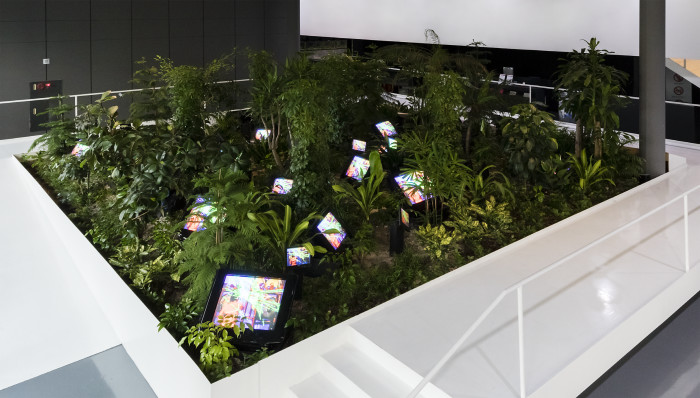
Televisions lie around as if blossoming, in this dense garden of real plants and bushes. What is played on the monitors is the video Global Groove which consists of dazzling sequences of music and dance from different parts of the world, from diverse types of art and culture, born out of Paik’s typical style of video synthesis. Without a master narrative of weaving the disparate elements, this video seems to recommend a simple and intuitive viewing. TV monitors in TV Garden reveal their presence by being placed at an unusual angle. Viewers are led to look down the television monitors facing upwards or lying on the side slantingly; they are led not to concentrate on one monitor but to watch multiple monitors at the same time. The natural environment which is artificially created and maintained inside the museum, and the television, a symbol of technology, which is often regarded as opposite to nature, form a single organic space. Here electronic images, coming from the television monitors and traveling through the leaves to the video’s musical rhythms, become part of the ecological space, in which Paik made the stimuli of pixels and the greens of foliage dance together in a constantly changing flux.
▶2.Nixon TV, 1965/2002, 2 TV monitors, coil, signal generator, amplifier, condenser, timer, 1channel video, color, silent, dimensions variable
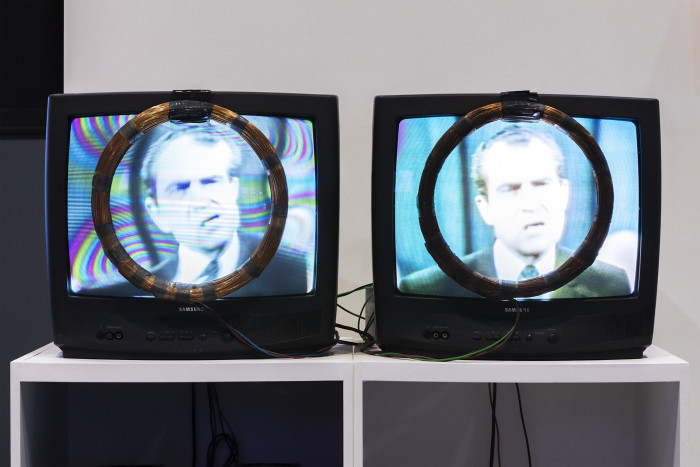
his work is one of the Paik’s earliest television experiments. Signals from the generator are amplified by the amp; electric currents flow through the coils installed on the two monitors. When the current flow is switched between the two monitors, it distorts the electric signals on the screens, making comical images of former American president Richard Nixon. Nixon was defeated by John F. Kennedy because he failed to win a positive image in the famous TV debate in 1960. Paik created this work by witnessing the turning point in the effects of media.
▶3. Exhibition Highlight of 《Electronic Art II》 at Galeria Bonino, 1968, 3min 34sec
Nam June Paik inaugurated one of his four solo exhibitions under the title of Electronic Art II at the Galeria Bonino, New York, in 1965. These exhibitions presented a video aesthetics different from that of his single channel videos aired by broadcasting stations. This video showed a sketch of the 1968 exhibition Electronic Art II featuring Paik’s experimental TVs and various video sculptors. One of the Paik’s works included in the video is Caged McLuhan which was produced with the same mechanism of Nixon TV. This variation of the face of the media theorist Marshall McLuhan gives us a clue to guess the complementary relationship between Paik and McLuhan who provided an insightful analysis of media in his classic book Understanding Media. Also, the video helps us to read the message of Paik’s media which found the interactive possibilities of TV, inspired by McLuhan’s idea of “the medium is the message,” meaning that TV is not a one-way medium but that there can be many variations on it through an artist’s intervention.
▶4. TV Clock, 1963–1977/1991, 24 manipulated TVs, dimensions variable
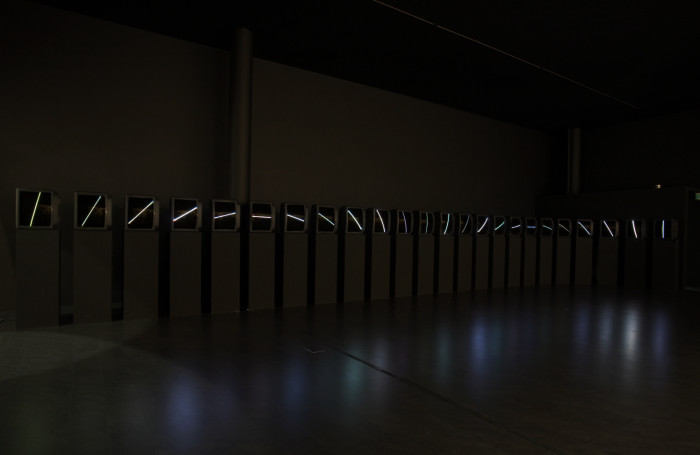
One of the early work of TV installation by Nam June Paik and this work consisted of 24 TV monitors. The 24 monitors symbolizing 24 hours a day and each monitor showing inclination the line in expressing time. This becomes feasible to remove inducement device of tube in TV and a line image visualized. 24 color TV monitors, this work convey the passage of time in the most peaceful atmosphere through meditation.
▶5. Charlie Chaplin, 2001, 4 CRT TVs, 4 radio’s cases, 1 LCD monitor, 2 bulbs, 1channel video, color, silent, 185 x 152 x 56 cm
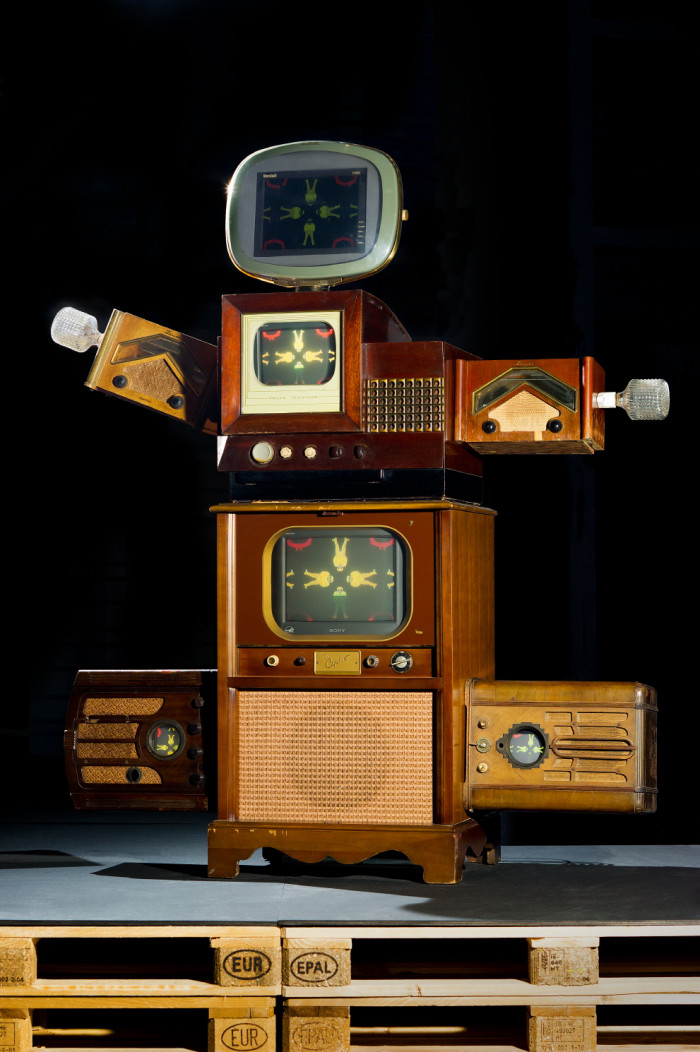
With movies such as The Gold Rush, Modern Times and The Great Dictator, Charlie Chaplin as a comic actor and a movie director continuously commented on the issue of recovering humanity in the age of materialism. In his masterpiece Modern Times, he depicted a society dominated by capitalism and machine civilization, and criticized the loss of humanity in his typical way of lyrical satire. Paik was also preoccupied with the issues of humanized technology and the harmony of humans and technologies, and so it is no wonder that Paik represented Chaplin in his robot sculpture. The body of Charlie Chaplin is composed of a vintage monitor, old televisions and radios, and the bulbs reminiscent of gas lamps in Chaplin’s films are its two hands, which has an oldworld atmosphere delivering nostalgia for the era of black and white films. Five monitors show the edited scenes from Chaplin’s movies.
▶6. Global Groove, 1973, 1channel video, color, sound, 29min 39sec
|
|
Produced in cooperation with WNET, the New York City public television station, and aired first on January 30, 1974, Global Groove is Paik’s representative video work that puts together a series of dance and music scenes from various cultures, as is suggested by the title. Beginning with Paik’s introductory statement that “this is a glimpse of a video landscape of tomorrow when you will be able to switch on any TV station on the earth and TV guides will be as fat as the Manhattan telephone book,” this video presents a counterpoint of Rock ‘n’ Roll and a drum sound played by female Navajo Indians and a collision between the Korean fan dance and a tap dance rhythm.
A combination between Beethoven’s Moonlight Sonata and Stockhausen’s electronic music also reinforces this coexistence of culturally conflicting elements to which are given equal status in this video. By puffins together g heterogeneous and opposing elements, Paik aimed to create a complex cultural map that would transcend national borders, in anticipation of the coming globalization that would be brought about by the TV.
▶7. Bob Hope, 2001, 2 CRT TVs, 3 LCD monitors, radios & CRT TV’s cases, 1 channel video, color, silent, 141 x 116 x 33 cm
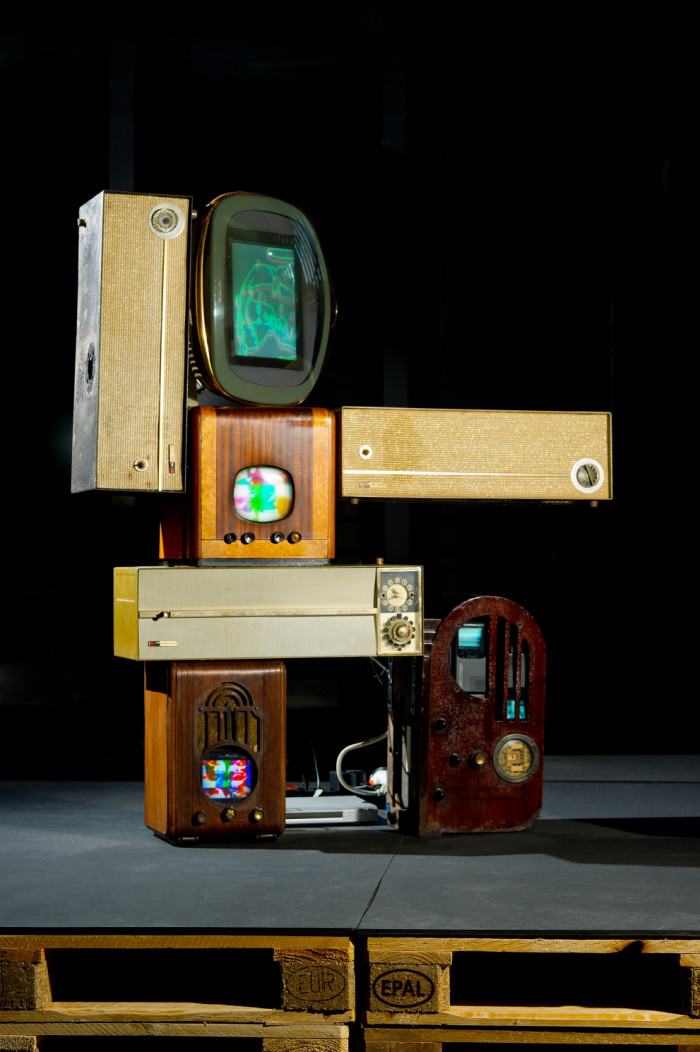
Bob Hope was a popular comedian, actor, singer, dancer and author, and made appearances in different fields including radio and television programs, movies and theaters. Paik made a series of works featuring such celebrities as Humphrey Bogart, David Bowie, Lauren Bacall and Marilyn Monroe as well as Hope. This is derived from Paik’s consistent interest from the 1970s in the power of mass media, the media consumption of images, the boundary between high art and popular art. In a broadcast program produced by ‘Cable Soho,’ the artists’ collective in New York, in 1984, we can see the artist.
Jaime Davidovich infiltrating a press conference with Hope and asking a question about video art and Paik. Hope did not know about these at all at that time; however, he expressed his positive views on a television of the future to be developed by experimental artists, and wished to become part of the future. As if to respond to this, Paik’s Bob Hope transforms Hope, the embodiment of the American television culture, into a kind of robot that is the past and the future of Hope at once.
▶8. Swiss Clock, 1988, closed-circuit camera, clock, 3 TV monitors, tripod, dimensions variable
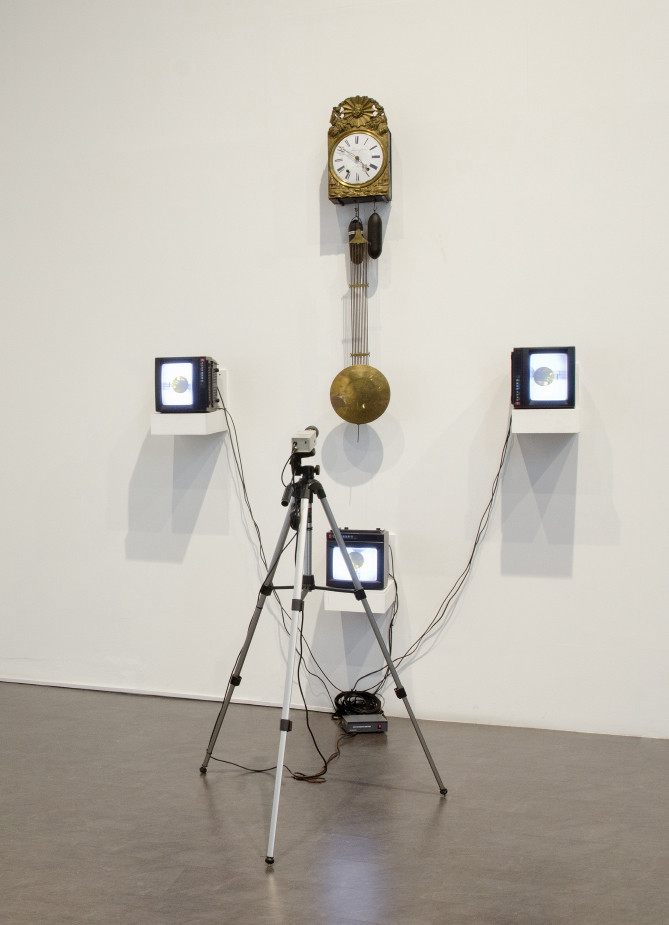
A CCTV camera captures the movement of a striking clock’s pendulum, which is screened on three televisions in real time. On the monitors that are placed in three different directions, the motion of the same pendulum is shown from three different angles. This work manifests the circular relationship between image and reality in the operation of closed-circuit TV. By recording the clock’s movement in this way, it also visually embodies the abstractness of flows of time. It may be said that Swiss Clock is one of the expressions of Nam June Paik’s interest in ‘non-linear time’
▶9. Fontainebleau, 1988, 20 Quasar color monitors, metal grid, gold-painted wooden frame, 2 channel video, color, silent, 195 x 235 x 4 cm
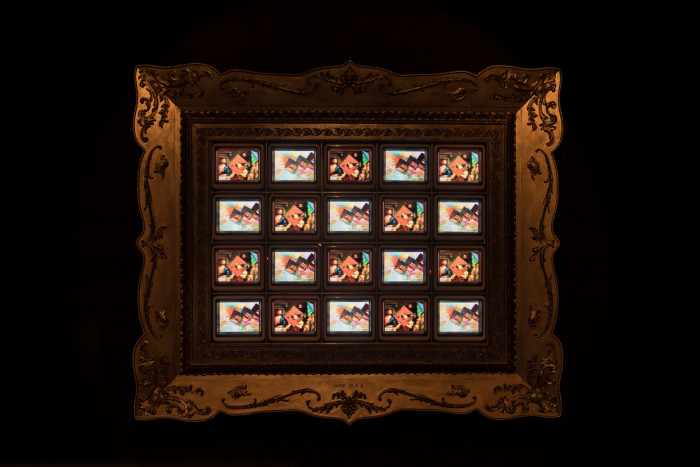
In a magnificent antique wooden frame painted in gold, 20 color (2-channel) monitors show rapidly-changing colorful abstract images. The title was probably taken from the Fontainebleau castle in France; the castle was not only the splendid residence of French kings including Napoleon but also a prototype of the ‘gallery,’ a space where paintings are hung side by side. The gallery of Francis I, in particular, displayed paintings on the walls surrounded by splendid gold decorations. “As the collage technique replaced oil painting, cathode ray tubes will replace canvas.” This is probably what Paik wanted to say through this work.
▶10. Zen for Film, 1964, 16mm film projector, film
The film is simply a transparent blank film, which accumulates dust and scratches as it passes through the projector over time with each successive screening. Zen for Film sets indetermined circumstance by being projected empty film. This is Paik’s analogy to John Cage’s 4’33” (1952) including noise and silence in the music.
▶11. Peter Moore Nam June Paik’s , as part of 《New Cinema Festival I》 at Filmmakers’ Cinematheque, New York, 1964, b & w photography, 40 x 59.5 cm
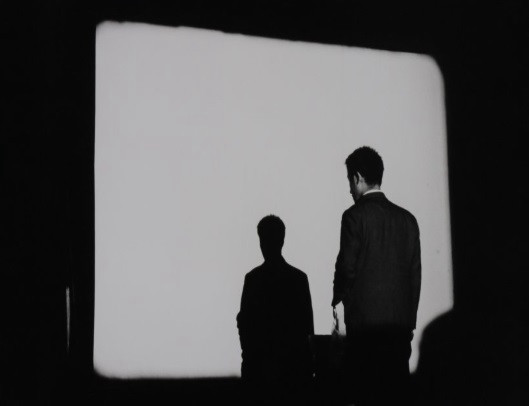
Paik stood in front of the running projector himself while performing Zen for Film as part of the New Cinema Festival I held at the Filmmakers’ Cinematheque in New York, as photographed by Peter Moore. The installation of the same name consists of an endless loop of unexposed film running through a projector. The resulting projected image shows a surface illuminated by a bright light, occasionally altered by the appearance of scratches and dust particles in the surface of the damaged film material.
When the viewer stands in front of the projector, their shape and movement becomes part of the performance.
▶12. I Wrote it in Tokyo in 1954, 1994, antique TV cabinet, 10 inch color CRT TV, mini CCTV camera, incandescent light bulb, Reuge 144-note music box, 49 x 48 x 47 cm
This work is based on Paik’s composition in one movement, consisting of 144 notes, which was composed during his first year in college. Paik incorporated the movement into his 1994 work in a way that it was played by an antique musical instrument made in the 18th century and then put it into an old TV set from the 1950s. The hypnotic image appearing on the screen shows the mechanism of a revolving music box. However, it is not an actual mechanical device but an image captured and projected in real time by a camera installed in a TV set. Paik combined the image of modern electronics and the tradition of old but familiar TVs and music boxes and thereby created an object which was a jumble of surrealism, poetry, and a little bit of camp. Here, the past, the present, and even the future which Paik was intended to show through his work all appear on the same screen.
▶13. Candle TV, 1975/1999, candle, TV case, 34 x 36 x 41 cm

A single lit candle stands inside the shell of a vintage TV. Light represents the beginning of human civilization. Paik once said that a light source is like a piece of information. In this work, he considered television the beginning of a new type of civilization.
▶14. The Rehabilitation of Genghis-Khan, 1993, TV monitor, 10 TV cases, diving helmet, neon tube, bicycle, fuel dispenser, plastic pipes, clothes, 1channel video, color, silent, 217 x 110 x 211 cm
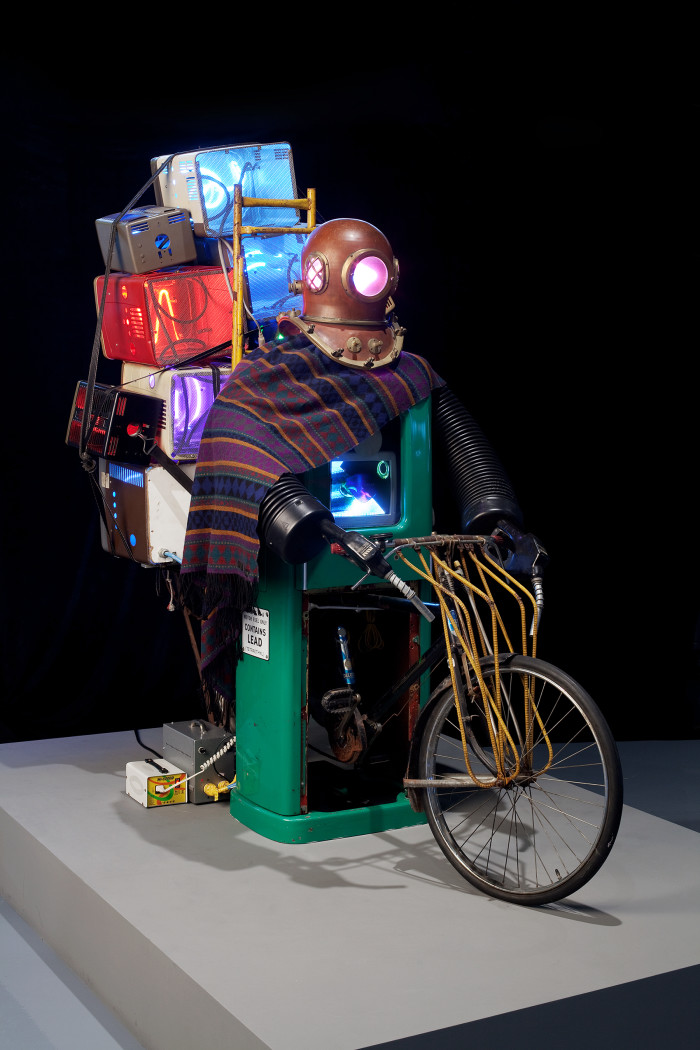
The Rehabilitation of Genghis-Khan is a robot sculpture produced on the occasion of the Venice Biennale 1993, materializing the concept of a new Silk Road that connects the East and the West has been substituted with a broadband electronic highway. This Genghis-Khan of the 20th century is riding a bike instead of a horse, wearing a diving helmet. His body is made of a fuel dispenser made of steel and his arms plastic pipes. The back of his bike is loaded with television cases, which are filled by symbols and characters made by neon lights. The neon symbols suggest a possibility of condensed delivery of complicated information through an electronic highway. The video displayed on the screens present a series of images that morph themselves, i.e. from a bottle to a pyramid and from a ceramic bowl to a kettle, while abstract geometrical patterns are alternating. In his robot sculptures such as Marco Polo, The Rehabilitation of Genghis-Khan, Alexander the Great and Tangun as a Scythian King, Nam June Paik emphasizes the coming of an age with a new paradigm that is realized with the help of software development through broadband communication, which is a step forward from the old age when power and domination were achieved by means of transportation and movement.
▶15. Key to the Highway(Rosetta Stone), 1995, Print, 86 x 71 cm
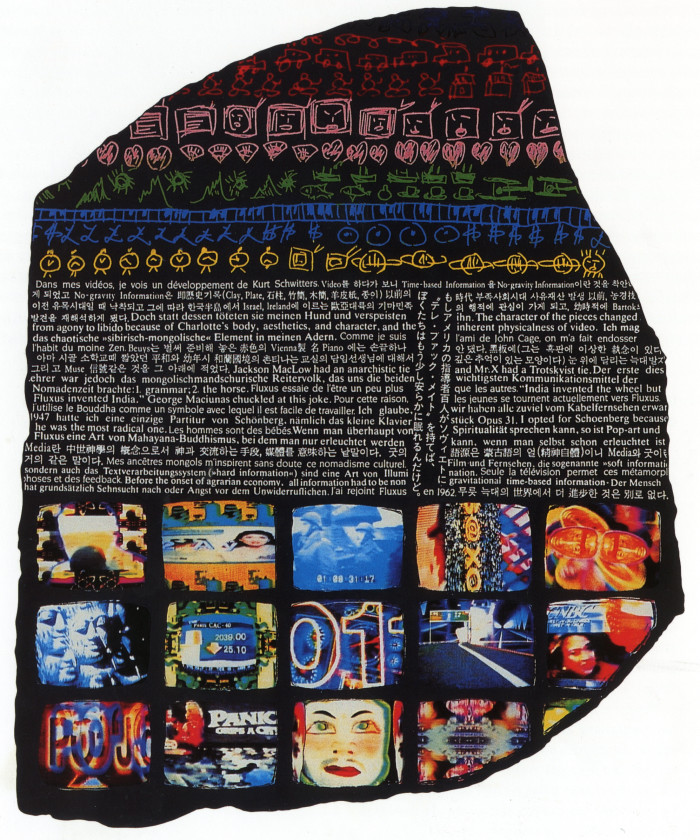
Paik realized his idea of ‘electronic superhighway’ in the shape of the Rosetta stone that was discovered in a small village called Rosetta by Napoleon’s army during his campaign in Egypt. The inscription on the Rosetta Stone was a decree issued by the ptolemaic Dynasty, un three languages: ancient Egypt in both its hieroglyphic and demotic script forms, and ancient Greek, is composed of a video drawing in the upper part, the description of Paik’s artistic career in many languages in the middle part, and images excerpted from his video art, how he participated in the Fluxus art movement, and the relationship with other artists who inspired and were inspired by him in four languages such as Korean, English, French, German, and Japanese – a great epitome of how and in what direction his art developed.
▶16. Joseph Beuys, Douglas Davis, and Nam June Paik Documenta 6 Satellite Telecast, 1977, color, sound, 29 min 11 sec
Documenta which takes place every five years in Kassel, Germany is one of the most important exhibitions of contemporary art. Documenta 6 in 1977 marked the first live international satellite telecast of artists’ performances. This project, involving three artists, Nam June Paik, Joseph Beuys, and Douglas Davis, was broadcast in more than 25 countries. Nam June Paik with Charlotte Moorman gave performances at this Documenta, such as TV Bra, TV Cello, TV Budda, and TV Bed, which combined various forms of art including music, performance, video sculpture, and TV. While giving the performances, Paik occasionally hinted that he and the TV audience could communicate with each other through satellite transmission. At the same place, Joseph Beuys announced his utopian notion of “social sculptor,” which is essential to his art, to the public. And Douglas Davis performed The Last Nine Minutes in Caracas, Venezuela, expressing the spatial / temporal distance between him and the audience by knocking at a television screen from inside the set.
▶17. TV Fish(Video Fish), 1975/1997, 24 TVs, 24 Fishes tanks, live fishes, 3 channel video, color, silent
|
|
24 televisions are placed behind a row of 24 fish tanks. Live fishes swim around inside the fish tanks while a series of moving images are played on the TV monitors, such as dancing Merce Cunningham, swimming fishes in the sea, and a flying airplane in the sky. The superimposition of a fish tank and a television monitor exerts the effect of spatiotemporally combining a real fish with a video image of fish. In the overlaps of images, Cunningham is dancing with a fish; fishes are swimming in the sky; and an airplane is floating in the sea. The visual composition, in which a fish tank becomes a monitor and vice versa, lets viewers look at the video images from a new perspective and perceive the television monitor as a frame defining and constraining what is shown. Dealing with the relationship between realities and representations across the frame of screens, Paik often employed elements from nature. He contrasted ‘being true-to-life’ of television images enabled by technology on the one hand, and the ‘aliveness’ of natural realities on the other, whereby he emphasized their coexistence and correspondence rather than bringing into relief their difference.
<Copyright(c)2002 GGC All rights reserved.>
information
Nam June Paik Exhibition Nam June Paik Media ‘n’ Mediea
Period/ 16 February, 2019(Sat) – 20 February, 2020(Thur)
Venue/ Nam June Paik Art Center 1F
Curated by/ Chaeyoung Lee(Curator, Nam June Paik Art Center)
Artists/ Nam June Paik
Organized and Hosted by/ Nam June Paik Art Center, Gyeonggi Cultural Foundation
keywords
- Writer
- About
